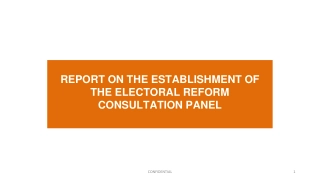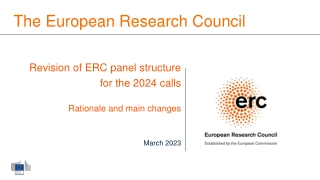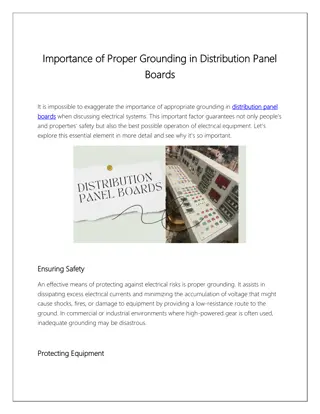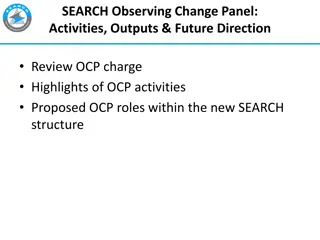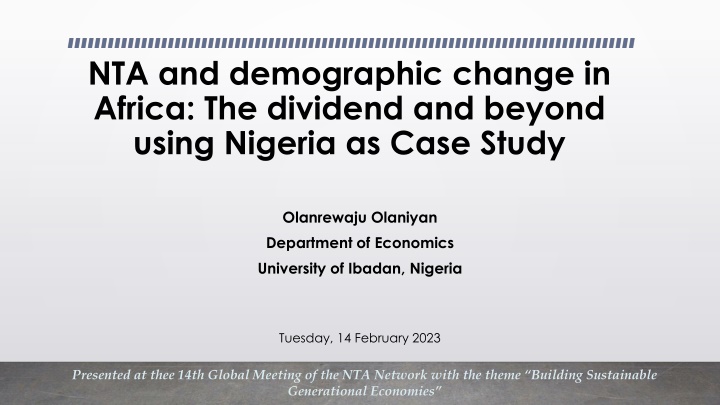
Demographic Change in Africa: The Dividend and Beyond - Insights from Nigeria
Explore the impact of demographic change in Africa, focusing on Nigeria as a case study. The presentation delves into the National Transfer Accounts (NTA), Strategic Programme, and more, shedding light on the population age structure, fertility rates, mortality rates, and workforce distribution. Gain valuable insights into the dynamics shaping sustainable generational economies.
Download Presentation

Please find below an Image/Link to download the presentation.
The content on the website is provided AS IS for your information and personal use only. It may not be sold, licensed, or shared on other websites without obtaining consent from the author. If you encounter any issues during the download, it is possible that the publisher has removed the file from their server.
You are allowed to download the files provided on this website for personal or commercial use, subject to the condition that they are used lawfully. All files are the property of their respective owners.
The content on the website is provided AS IS for your information and personal use only. It may not be sold, licensed, or shared on other websites without obtaining consent from the author.
E N D
Presentation Transcript
NTA and demographic change in Africa: The dividend and beyond using Nigeria as Case Study Olanrewaju Olaniyan Department of Economics University of Ibadan, Nigeria Tuesday, 14 February 2023 Presented at thee 14th Global Meeting of the NTA Network with the theme Building Sustainable Generational Economies
National Demographic Dividend Strategic Programme and Plan: The Nigerian Model National Transfer Accounts (NTA) for Estimation of DD profiles Advocacy and Sensitization Roadmap Preparation Monitoring and Evaluation Using NTA result to integrate DD into Plans and budgets Awareness Campaign Situation Analysis Gap Analysis Data Development and Institutionalization of the DD Assessment Index Setting up of an Observatory Body for DD activities Development of DD Roadmap Matrix Compilation, estimation, and NTA Profiles Sensitization Stakeholders' buy-in and Ownership of DD Estimation of DD Profile (duration and magnitude) Assigning Role to key Stakeholders
NTA is about Population Age structure and Development 12 12 56 20 Singapore 18 12 53 17 China 24 17 48 11 Malaysia 26 17 47 10 Indonesia 29 17 46 8 South Africa 19 13 46 22 USA 27 18 45 10 India 31 16 45 8 Lagos 30 19 42 8 Philippines 34 17 41 8 Egypt 42 20 33 5 SSA 44 19 33 5 Nigeria 0 20 40 60 60 + 80 100 0-14 15-24 25-59 Source: UN Population Prospects, 2020
Childhood mortality rates by State, 2018 Demographic Change is about Fertility and Mortality 250 200 119 150 100 51 50 0 Total fertility rate in Nigeria by States, 2018 SDG Targets 8 7.3 Infant mortality rate3 Under-five mortality rate5 7 6.5 7 5.4 6 5.3 4.5 5 4.3 4 3.4 3 2 1 0 LAGOS AKWA- CROSS OGUN OSUN RIVERS ENUGU ONDO FCT BAYELSA DELTA BENUE IMO OYO EKITI ANAMBRA PLATEAU EDO KOGI ABIA BORNO KWARA NASARAWA Nigeria EBONYI TARABA NIGER KADUNA YOBE ADAMAWA ZAMFARA KANO KEBBI GOMBE SOKOTO JIGAWA BAUCHI KATSINA Source: Drawn from data presented in NDHS 2018 Report
Who is who in Sokoto State? Who is who in Lagos State? Elderly, 139,166 , 2% Out of Labour 9% Employed, 969,596 , 16% Elderly 5% People as the core of development 3,012,871 , 50% d, 371,443 , 6% Children 31% Children, Underemploye Fully employed 32% Unemployed, 216,339 , 4% Unemployed 7% Underemploye d 16% Out of labour force, 1,329,874 , 22% NIGERIA, 2021 Old Age, 6,363 , 3% Employed, 32,927 , 15% Underemploye d*, 21,951 , 10% Children, 97,283 , 46% Unemployed*, 20,854 , 10% Out of labour, 34,024 , 16%
NTA is about contribution of different ages in the income and Consumption profiles Lagos State NTA Estimates Contribution of Different Age Groups to GDP by Consumption Expenditure Contribution of Different Age Groups to GDP by Production/Income Retired and other Elderly 5% Early retirees (55 - 64yrs) 9% Children (0-16yrs) 1% Retired and other Elderly 3% Early retirees (55 - 64yrs) 13% Children (0- 16yrs) 25% Youths (16-25) 10% Prime working age (26 - 54 yrs) 73% Youths (16- 25) 15% Prime working age (26 - 54 yrs) 46% Source: Estimates from the Computation of the Lagos State Demographic Dividend Profiles, 2020
NTA is about contribution of different ages in the income and Consumption profiles Kaduna State NTA Estimates CONTRIBUTION OF DIFFERENT AGE GROUPS TO GDP BY PRODUCTION/INCOME CONTRIBUTION OF DIFFERENT AGE GROUPS TO GDP BY CONSUMPTION EXPENDITURE Children (0-15yrs) 11% Children (0- 15yrs) 1% Youths (16 - 25 yrs) 6% Retired and other elderly (>64 yrs) 29% Retired and other elderly (>64 yrs) 26% Youths (16 - 25 yrs) 12% Early Retirees (55-64 yrs) 12% Early Retirees (55-64 yrs) 15% Prime Working age (26 - 54yrs) 52% Prime Working age (26 - 54yrs) 36% Source: Estimates from the Computation of the Kaduna State Demographic Dividend Profiles, 2020
How has NTA been used to further the goal of achieving economic development in Nigeria? Providing adequate information in a way that has not been not used before, Introduction of age into the GDP is novel and enhance acceptability of population in the development agenda NTA estimates for national and two states It makes it possible to analyse the relationship between population and age structure at the Subnational level thereby making demographic dividend meaningful at the subnational level. About four States have adopted NTA methodology for policy and implementation purposes The results of the estimation is being used for budget enhancement as it now forms the basis for budgeting in and development plan in at least two states and the federation (Two chapters in National Development Plan, 2021 2025 dedicated to population and demographic dividend Key component of the monitoring indicator of not just the DD but also development aspirations of the country
How can NTA be enhanced to improve its value for achieving development goals? Institutionalisation and commitment of government to NTA is a necessity. Government should utilise it for planning and funding of government activities Scaling up of NTA estimation and generation of NTA profiles at national and sub- national levels Recurrence - Regular production of DD estimates and monitoring of development activities. Can be done through integration of DD research evidence into National and state plans: Improvement in data availability and governance is important: Gap in population projection estimates by different States of the country. While nationally representative data are generally available and reliable, States and regional data for estimating the profiles are largely unavailable making it necessary for rapid surveys in order to get the profiles
How can NTA be enhanced to improve its value for achieving development goals? Recognition of Geographic disparities and diversities as important factors in the creation and reaping of demographic dividends Stakeholder engagement is key: Buy in of the relevant government stakeholders in the development of Roadmaps and other DD activities. The process of dissemination can be handled by the stakeholders for more acceptability within the country

